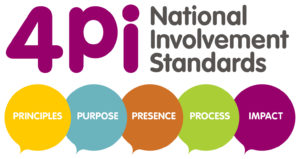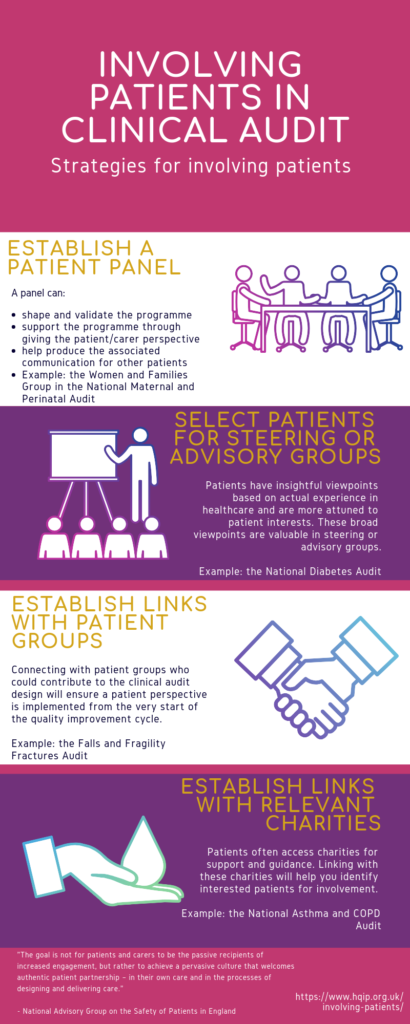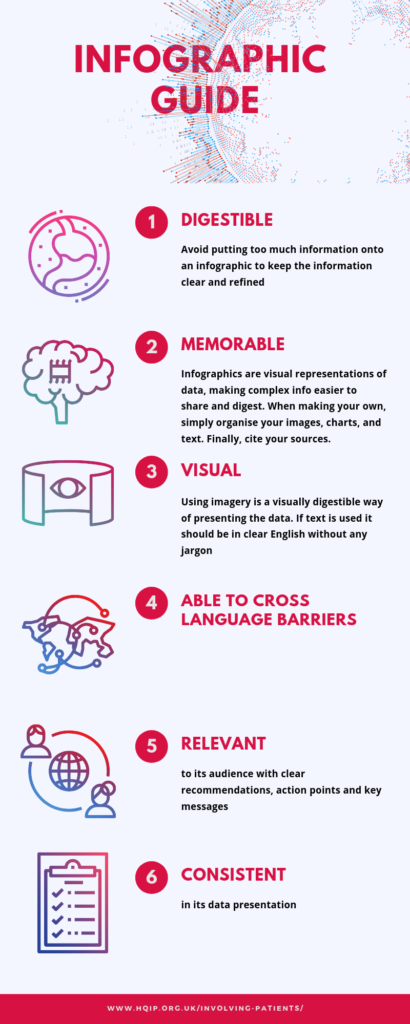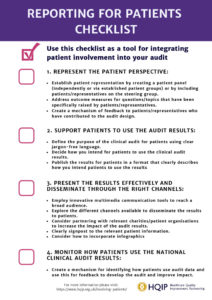Information for Providers – NCAPOP
The Healthcare Quality Improvement Partnership (HQIP) is committed to ensuring that patient and public involvement (PPI) is a core value and strategic objective that is reflected throughout our work.
We adhere to seven principles of PPI (4PI National Involvement Standards) which are an integral part of our commissioning agreement with each provider within the National Clinical Audit and Patient Outcomes Programme (NCAPOP). ‘PPI’ is written as an acronym for Patient and Public involvement. This term refers to patients, service users, carers, children and young people and the general public. ‘Patients’ is also used as a general term to include all the above.
Our expectation of HQIP commissioned programmes is to ensure that patients and carers are involved in the structures and processes of their project in a meaningful way.
Contact the HQIP PPI team (Kim Rezel) for further information and support to deliver any of the suggested initiatives.
- 1. Involving patients in the development of a national clinical audit
Service User Network (SUN) members consider the involvement of patients in designing a clinical audit as an important factor for ensuring that the audit contains patient-focused metrics and reports results that are relevant for patients.
Providers include outcome measures for questions/topics that have been specifically raised by patients. These questions were designed with input from patient/parent/public representatives who formed part of the clinical audit’s steering committee, through the use of patient surveys or by addressing frequently asked questions from service users. SUN members advised that the process of discussion and co-production should be reflected in the results so that it is clear for patients that these sections are targeted at them.
Strategies for involving patients/public representatives (with examples):
- establish a patient panel – National Maternal and Perinatal Audit, My Arthritis Audit, National Obesity Audit
- select patients/representatives onto the clinical audit steering group/advisory group – National Diabetes Audit
- establish links with patient groups who could contribute to the clinical audit design – Falls and Fragility Fractures Audit Project
- establish links with relevant charities that can provide access to patient networks – National Asthma and COPD Audit Programme
- proactive communications and development plans in place to engage diverse people and communities – NHS England: Diverse and inclusive participation
- coping strategies for maintaining PPI in a time of crisis – 2020 case studies
Closing the feedback loop
Providers should feedback to the patients who contribute to the audit design so that they remain engaged and continue to support the development of the audit so that it evolves and maintains its relevance with patient groups.- 2. Supporting patients to use audit results
In order for the published information to be beneficial for patients, providers should clearly state how patients could use this information to meet their healthcare needs.
The role of national clinical audit is still poorly understood by many service users and clarity of purpose could help to increase public engagement with the national clinical audit outputs.
When publishing information consider the different ways in which the information may be used by patients and their representatives:
- to provide guidance on the important questions patients should ask regarding their care – The National Joint Registry
- to understand recommendations for improving their management of a condition – National Bowel Cancer Audit
- to find out the standards of care at their local hospital compared to the rest of the country
- to understand available treatment options – Falls and Fragility Fracture Audit Programme
- to participate in the co-production of local service improvement projects – Developing a Patient and Public Involvement Panel for Quality Improvement, A guide to Patient and Public Involvement in Quality Improvement
These intentions should be decided at the outset and should help to plan how the results are presented to patients.
- 3. Presenting information to patients
To reach a broad audience, it is important to utilise the range of communication tools available. The majority of providers use more than one means through which patients can access the audit’s results.
Information should be disseminated to the people who receive care through the channels that they will access. SUN members identified the following channels to find information about their health condition:
- NHS Directory for data on speciality treatments
- NHS Trust websites
- GP practices
Cultivate relationships between national clinical audit providers, patient groups, charities, NHS trusts and service commissioners so that information can be signposted between these different stakeholders.
How to align your national clinical audit with the channels most commonly identified by patients:
- build relationships with relevant charities to help shape the clinical audit and signpost to audit results through the condition-specific and charity websites – National Diabetes Audit (an example of a programme with charities and patients and carers on the steering group)
- develop links from NHS Trust websites to direct interested parties to further information on your audit website page
- clear signposting to patient information on the audit website including information about local services and whether standards have been implemented locally – National Bowel Cancer Audit
- patient information leaflets at GP practices or hospital outpatients – National Prostate Cancer Audit
- build relationships with relevant patient groups who can inform the design of the audit and disseminate the results
- utilise hard copy media e.g. patient representatives writing magazine articles
- social media campaigns
Use innovative ways to present the clinical audit information to patients:
- Infographics – National Emergency Laparotomy Audit
An effective infographic should be:
- One page summary – National Diabetes Transition Audit
- Picture Animations
- YouTube videos – Falls and Fragility Fractures Programme
- Interactive online results map – Sentinel Stroke National Audit Programme
- Patient booklet – Paediatric Intensive Care Audit Network
- “Patient decision aid” tool for a more individual view of data – National Neonatal Audit Programme
- 4. Measuring the impact of the audit information
Do you measure the impact of your audit report on patients? Having an understanding of how patients are using data can capture the benefits of the audit for patients.
The patient experience should be routinely monitored and evaluated in order to inform and shape the patient experience.
The following mechanisms can be used to identify the uptake and use of the audit information:
- monitor visits to the audit website
- monitor downloads of patient and public guides
- monitor patient comments on audit website (consider developing this function if not currently available) or patient group forums
- collect patient feedback
- download analytics from patient facing websites
- feedback from patient representatives on the clinical audit steering group
- develop online system to collect and analyse patient feedback
- commission a patient workshop to receive feedback
- 5. Reporting for Patients Checklist
The following checklist can be used as a guide to help carry out the key steps for integrating patient involvement into clinical audit. Please print this out by clicking on it.





